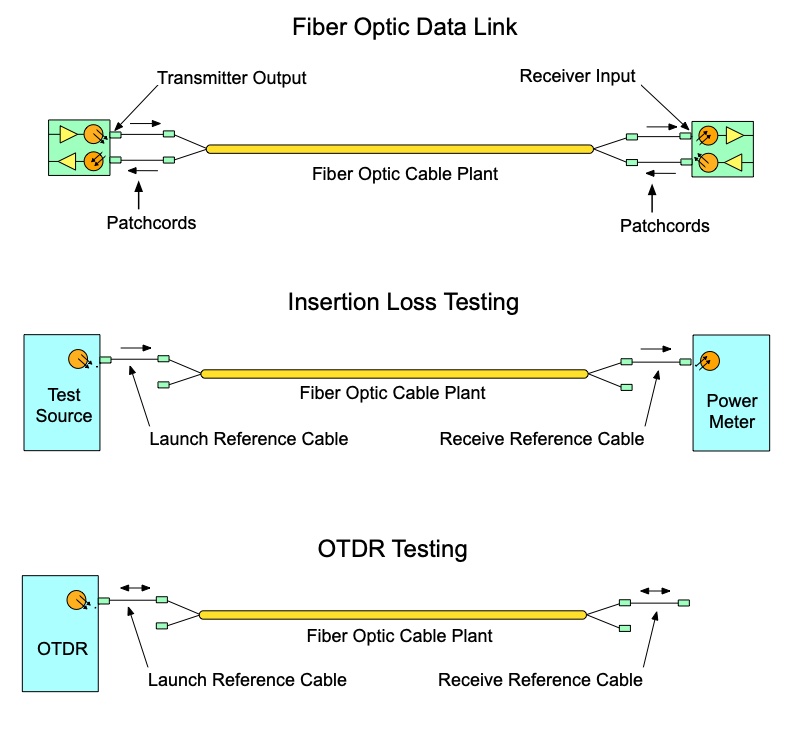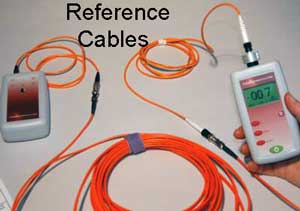Reference Cables For Fiber
Optic Testing MiniCourse
Fiber
U MiniCourses are courses on a specific topic that you can
take in about an hour or less. They are based on questions
people ask FOA all the time, so the topics are recommended
by our readers.
This Fiber U MiniCourse covers the reference cables used in fiber optic
testing, both insertion loss testing with a light source and power meter
and OTDR testing.
Level: Intermediate
Intended For:
Technicians testing fiber optic communications networks
Users
of fiber optic communications networks
Contractors and techs who install, test, operate and maintain fiber optic networks.
Objectives:
From this self-study program you should learn:
The reasons reference cables are needed for fiber optic testing
3 reference cable configurations for insertion loss testing and why they are needed
2 configurations of OTDR reference cables and the reasons to use each
- Prerequisites
You will need a basic understanding of fiber optics and particularly fiber optic testing,
e.g. training and a FOA CFOT certification or at least a
familiarity with fiber optic technology.
If you need a review of fiber optic testing, we suggest you begin with the Testing Lesson in the Fiber
U Basic Fiber Optics self-study course or the more complete Fiber U Testing Course.

When
you finish, you can take an online test on this course to
qualify for a "Fiber U Certificate of Completion." The
test cost for a Fiber U MiniCourse is $10US.
Introduction
In order to test cables with a power meter and source or with an OTDR,
one needs to establish test conditions. The test conditions are similar
to how the actual cable plant will be used when communications equipment
is connected (see below.) For insertion loss testing, this
requires reference launch jumper cables to connect the test source to
the fiber in the cable under test and receive cables to connect the
fiber optic power meter. For OTDR testing, this requires a reference
launch cable to connect the OTDR to the fiber in the cable under test
and a receive cable at the far end of the fiber.

These reference cables must be chosen carefully and maintained properly
for testing to be accurate. This Fiber U Minicourse will cover the topic
of reference cables and how they affect loss measurements of the fiber
optic cable plant.
Assignments
For
this lesson plan you will be instructed to watch the
videos, read
the references
and take a quiz (Test Your Knowledge) to complete the
course.
Lesson
Plan
Watch
the videos, read the section in the FOA Guide and take
the quiz. For this course, we recommend watching the
videos first and then reading the FOA Guide page on
Restoration. There is a short quiz you can use to check
your comprehension. The Certificate of Completion test
is based on those materials.
Videos
FOA Lesson 71 Reference Cables For Fiber Optic Testing (YouTube)
FOA Guide
Reference Test Jumper Cables And Mating Adapters
Review: Testing The Fiber Optic Cable Plant - 5 Standard Ways
Test Your Comprehension
Fiber Optic Reference Cables Quiz.

When
you finish all the assignments you can take an online test
on this course to qualify for a "Fiber U Certificate of
Completion." The test cost is $10US.
Go here to take the Fiber U "Reference Cables MiniCourse"
Certificate of Completion test. Here
are detail directions if this is your first time
taking a Fiber
U Certificate of Completion exam.
This information is
provided by The Fiber Optic Association, Inc. as a
benefit to those interested in teaching, designing,
manufacturing, selling, installing or using fiber optic
communications systems or networks. It is intended to be
used as an overview and/or basic guidelines and in no
way should be considered to be complete or
comprehensive. These guidelines are strictly the opinion
of the FOA and the reader is expected to use them as a
basis for learning, as a reference and for creating
their own documentation, project specifications, etc.
Those working with fiber optics in the classroom,
laboratory or field should follow all safety rules
carefully. The FOA assumes no liability for the use of
any of this material.
|



